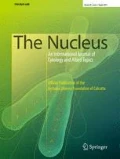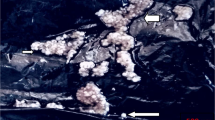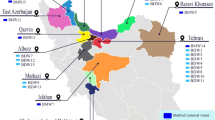Abstract
Heavy metals are ubiquitous environmental and occupational genotoxicants with different absorbability and toxicokinetics towards increasing genetic damage, neoplasm and cell death. Aquatic organisms are exposed to individuals and/or mixtures of these metals. This study investigated the potentials for cadmium(II) (Cd), lead(II) (Pb), manganese(II) (Mn), and their mixture (CPM) to induce cytogenotoxicity in Clarias gariepinus (Family: Clariidae). Clarias gariepinus was exposed to six concentrations ranging from 0 to 1600 mg/L, selected from range finding tests, to evaluate the 96 h acute toxicity for the individual metals and CPM. Fish were exposed to sub-lethal concentrations (6.25, 12.5 25, 50, and 100% of the 96 h LC50) of each metal and their mixture for 7 days to investigate micronucleus (MN) and abnormal nuclei (NAs) in the peripheral blood erythrocytes. Fish were exposed to borehole tap water and 0.01 mL/L of Benzene as negative and positive controls respectively. The tested metals induced toxicity in the order CMP > Cd > Pb > Mn, with CPM (LC50 = 40.6 mg/L) being 11.5 times more toxic than Mn (LC50 = 478.2 mg/L), the least toxic metal, to juvenile catfish. All the tested metals induced significant increase in frequencies of MN and NAs. The induced MN and NAs were in the order CMP > Cd > Mn > Pb. Fragmented and necrotic cells were common NAs in fish treated with 50 and 100% of Cd and CPM, suggesting that severely damaged cells were eliminated by programmed cell death (apoptosis) and/or accidental cell death (necrosis). Antagonistic interaction among the composite mixture of CPM provoked greater genomic instability and cytotoxicity in fish. Significant increase in MN and NAs in exposed fish suggest increased genomic instability which may lead to increase health defects including neoplasms and genetic related disorders, cell dysfunction and/or cell death.



Similar content being viewed by others
References
Abdullah S, Javed M, Javid A. Studies on acute toxicity of metals to the fish (Labeo rohita). Int J Agric Biol. 2007;9(2):333–7.
Alcala-Orozco M, Morillo-Garcia Y, Caballero-Gallardo K, Olivero-Verbe J. Mercury in canned tuna marketed in Cartagena, Colombia, and estimation of human exposure. Food Addit Contam Part B. 2017;10(4):241–7.
Alimba CG, Adekoya KO, Soyinka OO. Exposure to effluent from pharmaceutical industry induced cytogenotoxicity, hematological and histopathological alterations in Clarias gariepinus (Burchell, 1822). EXCLI J. 2019;18:63–78.
Alimba CG, Ajayi EO, Hassan T, Sowunmi AA, Bakare AA. Cytogenotoxicity of abattoir effluent in Clarias gariepinus (Burchell, 1822) using micronucleus test. Chin J Biol. 1822;2015:1–6. https://doi.org/10.1155/2015/624524.
Alimba CG, Ajiboye RD, Fagbenro OS. Dietary ascorbic acid reduced micronucleus and nuclear abnormalities in Clarias gariepinus (Burchell 1822) exposed to hospital effluent. Fish Physiol Biochem. 2017;43(5):1325–35.
Alimba CG, Aladeyelu AM, Nwabisi IA, Bakare AA. Micronucleus cytome assay in the differential assessment of cytotoxicity and genotoxicity of cadmium and lead in Amietophrynus regularis. EXCLI J. 2018;17:89–101.
Alimba CG, Bakare AA. In vivo micronucleus test in the assessment of cytogenotoxicity of landfill leachates in three animal models from various ecological habitats. Ecotoxicology. 2016;25:310–9.
Alimba CG, Dhillon V, Bakare AA, Fenech M. Genotoxicity and cytotoxicity of chromium, copper, manganese and lead, and their mixture in WIL2-NS human B lymphoblastoid cells is enhanced by folate depletion. Mutat Res. 2016;798–9:35–47.
Alimba CG, Saliu JK, Ubani-Rex OA. Cytogenotoxicity and histopathological assessment of Lekki Lagoon and Ogun River in Synodontis clarias (Linnaeus, 1758). Toxicol Environ Chem. 2015;97(2):221–34.
Al-Sabti K, Metcalfe CD. Fish micronuclei for assessing genotoxicity in water. Mutat Res. 1995;343:121–35.
Anderson PD, Weber LJ (1975) The toxicity to aquatic population of mixtures containing certain heavy metals. In: Proceeding of the international conference on heavy metal in the environment. Institute of Environmental Studies, University of Toronto, pp. 933–953
ATSDR (Agency for Toxic Substances and Disease Registry) (1997) CERCLA priority list of hazardous substances that will be the subjects of toxicological profiles and support document, U.S. Department of Health and Human Services
ATSDR (Agency for Toxic Substances and Disease Registry) (1998) Toxicological profile for lead, US Department of Health and Human Services, Atlanta, GA
Bahari IB, Noor FM, Daud NM. Micronucleated erythrocytes as an assay to assess actions by physical and chemical genotoxic agents in Clarias gariepinus. Mutat Res. 1994;313:1–5.
Bawa-Allah KA, Saliu JK, Otitoloju AA. Heavy metal pollution monitoring in vulnerable ecosystems: a case study of the Lagos Lagoon, Nigeria. Bull Environ Contam Toxicol. 2018;100(5):609–13.
Cai F, Calisi RM. Seasons and neighborhoods of high lead toxicity in New York City: the feral pigeon as a bio-indicator. Chemosphere. 2016;161:274–9.
Carrasco KR, Tilbury KL, Myers MS. Assessment of the piscine micronucleus test as an in situ biological indicator of chemical contaminant effects. Can J Fish Aquat Sci. 1990;47:2123–36.
Carroll RE. The relationship of cadmium in the air to cardiovascular disease rates. J Am Med Assoc. 1966;198:267–9.
Cavas T, Garanko NN, Arkhipchuk VV. Induction of micronuclei and binuclei in blood, gill and liver cells of fishes subchronically exposed to cadmium chloride and copper sulphate. Food Chem Toxicol. 2005;43:569–74.
Conceicao LEC, Dersjant-Li Y, Verreth JAJ. Cost of growth in larval and juvenile African catfish (Clarias gariepinus) in relation to growth rate, food intake and oxygen consumption. Aquaculture. 1998;161(1–4):95–106.
Crossgrove J, Zheng W. Manganese toxicity upon overexposure. NMR Biomed. 2004;17:544–53.
Dai W, Liu S, Fu L, Du H, Xu Z. Lead (Pb) accumulation, oxidative stress and DNA damage induced by dietary Pb in tilapia (Oreochromis niloticus). Aquac Res. 2012;43:208–14.
Das BK, Kaviraj A. Individual and interactive lethal toxicity of cadmium, potassium permanganate and cobalt chloride to fish, worm and plankton. Geobios. 1994;21:223–7.
Demirak A, Yilmaz F, Tuna AL, Ozdemir N. Heavy metals in water, sediment and tissues of Leuciscus cephalus from a stream in southwestern Turkey. Chemosphere. 2006;63:1451–8.
DeRosa CT, Johnson BL, Fay M, Hansen H, Mumtaz MM. Public health implications of hazardous waste sites: findings, assessment, and research. Food Chem Toxicol. 1996;34:1131–8.
Dutta TP, Kaviraj A. Acute toxicity of cadmium to fish Labeo rohita and copepod Diaptomus forbesi pre-exposed to CaO and KMnO4. Chemosphere. 2001;42(8):955–8.
EIFAC (European Inland Fisheries Advisory Commission) (1998) Revised report on fish toxicology testing procedures. FAO, Rome. (EIFAC technical paper, no. 24)
Elsokkary IH, Muller G. Assessment and speciation of chromium, nickel, lead and cadmium in the sediments of the River Nile, Egypt. Sci Total Environ. 1990;97(98):455–63.
Fasakin EA, Balogun AM, Ajayi OO. Evaluation of full-fat and defatted maggot meals in the feeding of clariid catfish Clarias gariepinus Fingerlings. Aquac Res. 2003;34:733–8.
Ferraro MVM, Fenocchio AS, Mantovani MS, Ribeiro CDO, Cestari MM. Mutagenic effects of tributyltin and inorganic lead (Pb II) on the fish H. malabaricus as evaluated using the comet assay and the piscine micronucleus and chromosome aberration tests. Genet Mol Biol. 2004;27:103–7.
Fish JT. Groundwater water treatment for iron and manganese reduction and fish rearing studies applied to the design of the Ruth Burnett Sport Fish Hatchery, Fairbanks, Alaska. Aquac Eng. 2009;41:97–108.
Fulda S, Gorman AM, Hori O, Samali A. Cellular stress responses: cell survival and cell death. Int J Cell Biol. 2010;214074:1–23.
Gabriel D, Riffel APK, Finamor IA, Saccol EMH, Ourique GM, Goulart LO, et al. Effects of sub-chronic manganese chloride exposure on Tambaqui (Colossoma macropomum) tissues: oxidative stress and antioxidant defenses. Arch Environ Contam Toxicol. 2013;64:659–67.
Gil F, Hernández AF, Márquez C, Femia P, Olmedo P, López-Guarnido O, Pla A. Biomonitorization of cadmium, chromium, manganese, nickel and lead in whole blood, urine, axillary hair and saliva in an occupationally exposed population. Sci Total Environ. 2011;409(6):1172–80.
Gisselsson D, Bjork J, Hoglund M, Mertens F, Cin PD, Åkerman M, Mandahl N. Abnormal nuclear shape in solid tumors reflects mitotic instability. Am J Pathol. 2001;158(1):199–206.
Griffin BR, Davis KB, Darwish A, Straus DL. Effect of exposure to potassium permanganate on stress indicators in channel catfish Ictalurus punctatus. J World Aquac Soc. 2002;33(1):1–9.
Hambach R, Lison D, D’Haese PC, Weyler J, De Graef E, De Schryver A, Lamberts LV, van Sprundel M. Co-exposure to lead increases the renal response to low levels of cadmium in metallurgy workers. Toxicol Lett. 2013;222:233–8.
Howe PD, Malcolm HM, Dobson S (2004) Manganese and its compound: environmental aspects. Concise international chemical assessment document, 63rd edn. World Health Organization, New York
IARC (International Agency for Research on Cancer) (1993) Summaries and evaluations: cadmium and cadmium compounds (group 1). In: IARC monographs on the evaluation of carcinogenic risks to humans, vol 58, Lyon
IARC (International Agency for Research on Cancer) (2006) Inorganic and organic lead compounds. In: IARC monographs on the evaluation of carcinogenic risks to humans, vol 87, Lyon
IPCS (International Programme on Chemical Safety) (1993) Benzene. WHO, Geneva (Environmental Health Criteria, No. 150)
IPCS (International Programme on Chemical Safety) (1992) Cadmium. WHO, Geneva (Environmental Health Criteria, No. 134)
Jarup L. Hazards of heavy metal contamination. Br Med Bull. 2003;68:167–82.
Jindal R, Verma S. In vivo genotoxicity and cytotoxicity assessment of cadmium chloride in peripheral erythrocytes of Labeo rohita (Hamilton). Ecotoxicol Environ Saf. 2015;118:1–10.
Katsifis SP, Kinney PL, Hosselet S, Bums FJ, Christie NT. Interaction of nickel with mutagens in the induction of sister chromatid exchanges in human lymphocytes. Mutat Res. 1996;359:7–15.
Keen-Kim D, Nooraie F, Nagesh Rao P. Cytogenetic biomarkers for human cancer. Front Biosci. 2008;13:5928–49.
Lambertucci SA, Donázar JA, Huertas AD, Jiménez B, Sáez M, Sanchez-Zapata JA, Hiraldo F. Widening the problem of lead poisoning to a South-American top scavenger: lead concentrations in feathers of wild Andean condors. Biol Conserv. 2011;144:1464–71.
Li Y, Qin J, Wei X, Li C, Wang J, Jiang M, et al. The risk factors of child lead poisoning in China: a meta-analysis. Int J Environ Res Public Health. 2016;13:296–309.
Lin Y, Ling M, Chen S, Chen W, Hsieh N, Cheng Y, et al. Mixture risk assessment due to ingestion of arsenic, copper, and zinc from milkfish farmed in contaminated coastal areas. Environ Sci Pollut Res. 2017;24:14616–26.
Liu W, Zhou Q, An J, Sun Y, Liu R. Variations in cadmium accumulation among Chinese cabbage cultivars and screening for Cd-safe cultivars. J Hazard Mater. 2010;173:737–43.
Lo Y, Dooyema CA, Neri A, Durant J, Jefferies T, Medina-Marino A, et al. Childhood lead poisoning associated with gold ore processing: a village-level investigation—Zamfara State, Nigeria, October–November 2010. Environ Health Perspect. 2012;120:1450–5.
Martinez CBR, Nagae MY, Zaia CTBV, Zaia DAM. Acute morphological and physiological effects of lead in the neotropical fish Prochilodus lineatus. Braz J Biol. 2004;64(4):797–807.
Matsunami J. Hundred years of cadmium poisoning: recollection and prospects, Katsura Shobo, Toyama (2010). In: Kaji M: Role of experts and public participation in pollution control: the case of Itai-itai disease in Japan. Ethics Sci Environ Polit. 2010;12:99–111.
Naigaga I, Kaiser H, Muller WJ, Ojok L, Mbabazi D, Magezi G, Muhumuza E. Fish as bioindicators in aquatic environmental pollution assessment: a case study in Lake Victoria wetlands, Uganda. Phys Chem Earth. 2011;36:918–28.
Nersesyan A, Kundi M, Waldherr M, Setayesh T, Mišík M, Wultsch G, et al. Results of micronucleus assays with individuals who are occupationally and environmentally exposed to mercury, lead and cadmium. Mutat Res. 2016;770:119–39.
Nriagu JO. Cupellation: the oldest quantitative chemical process. J Chem Educ. 1985;62:668–74.
Nriagu JO. A silent epidemic of environmental metal poisoning? Environ Pollut. 1988;50:139–61.
Nriagu JO. Global metal pollution: poisoning the biosphere? Environ Sci Policy Sustain Dev. 1990;32(7):7–33.
OECD (Organization for Economic Cooperation and Development) (1992) Guidelines for testing of chemicals. Guideline no. 203: fish, acute toxicity test
O’Neal SL, Zheng W. Manganese toxicity upon overexposure: a decade in review. Curr Environ Health Rep. 2015;2:315–28.
Osman AGM, Abd El Reheen AM, Moustafa MA, Mahmoud UM, Abuel-Fadl KY, Kloas W. In situ evaluation of the genotoxic potential of the river Nile: I. Micronucleus and nuclear lesion tests of erythrocytes of Oreochromis niloticus niloticus (Linnaeus, 1758) and Clarias gariepinus (Burchell, 1822). Toxicol Environ Chem. 2011;93(5):1002–17.
Özkan F, Gündüz SG, Berköz M, Özlüer Hunt A. Induction of micronuclei and other nuclear abnormalities in peripheral erythrocytes of Nile tilapia, Oreochromis niloticus, following exposure to sublethal cadmium doses. Turk J Zool. 2011;35(4):585–92.
Pal D, Maiti SK. Seasonal variation of heavy metals in water, sediment, and highly consumed cultured fish (Labeo rohita and Labeo bata) and potential health risk assessment in aquaculture pond of the coal city, Dhanbad (India). Environ Sci Pollut Res. 2018;25(13):12464–80.
Risso-de Faverney C, Devaux A, Lafaurie M, Girard JP, Baillya B, Rahmani R. Cadmium induces apoptosis and genotoxicity in rainbow trout hepatocytes through generation of reactive oxygen species. Aquat Toxicol. 2001;53:65–76.
Romeo M, Mathieu A, Gnassia-Barelli M, Romana A, Lafaurie M. Heavy metal content and biotransformation enzymes in two fish species from the NW Mediterranean. Mar Ecol Prog Ser. 1994;107(1/2):15–22.
Satarug S, Baker JR, Urbenjapol S, Haswell-Elkins M, Reilly PEB, Williams DJ, et al. A global perspective on cadmium pollution and toxicity in non-occupationally exposed population. Toxicol Lett. 2003;137:65–83.
Schlenk D, Colley WC, El-Alfy A, Kirby R, Griffin BR. Effects of the oxidant potassium permanganate on the expression of gill metallothionein mRNA and its relationship to sublethal whole animal endpoints in channel catfish. Toxicol Sci. 2000;54:177–82.
Sevcikova M, Modra H, Slaninova A, Svobodova Z. Metals as a cause of oxidative stress in fish: a review. Vet Med. 2011;56(11):537–46.
Shaukat N, Javed M, Ambreen F, Latif F. Oxidative stress biomarker in assessing the lead induced toxicity in commercially important Fish, Labeo rohita. Pak J Zool. 2018;50(2):735–41.
Shimizu N, Itoh N, Utiyama H, Wahl GM. Selective entrapment of extra-chromosomally amplified DNA by nuclear budding and micronucleation during S phase. J Cell Biol. 1998;140(6):1307–20.
Singh M. Heavy metal pollution in freshly deposited sediments of the Yamuna river (the Ganges River tibutary): a case study from Delhi and Agra Urban centres, India. Environ Geol (Berlin). 2001;40(6):664–71.
Slaninova A, Machova J, Svobodova Z. Fish kill caused by aluminium and iron contamination in a natural pond used for fish rearing: a case report. Vet Med. 2014;59(11):573–81.
Sun H, Li Y, Ji Y, Yang L, Wang W, Li H. Environmental contamination and health hazard of lead and cadmium around Chatian mercury mining deposit in western Hunan Province, China. Trans Nonferr Met Soc China. 2010;20:308–14.
Taweel A, Shuhaimi-Othman M, Ahmed AK. In vivo acute toxicity tests of some heavy metals to Tilapia fish (Oreochromis niloticus). J Biol Sci. 2013;13(5):365–71.
Torres C, Creus A, Marcos R. Genotoxic activity of four inhibitors of DNA topoisomerases in larval cells of Drosophila melanogaster as measured in the wing spot assay. Mutat Res. 1998;413:191–203.
Tucker CS, Boyd CE. Relationships between potassium permanganate treatment and water quality. Trans Am Fish Soc. 1977;106:481–8.
Tuzuki BLL, Delunardo FAC, Ribeiro LN, de Melo CP, Gomes LC, Chippari-Gomes AR. Effects of manganese on fat snook Centropomus parallelusi (Carangaria: Centropomidae) exposed to different temperatures. Neotrop Ichthyol. 2017;15(4):e170054(1–9).
Udroiu I. The micronucleus test in piscine erythrocytes. Aquat Toxicol. 2006;79:201–4.
Verstraeten VL, Peckham LA, Olive M, Capell BC, Collins FS, Nabel EG, et al. Protein farnesylation inhibitors cause donut-shaped cell nuclei attributable to a centrosome separation defect. Proc Natl Acad Sci USA. 2011;108(12):4997–5002.
Wang D, Du X, Zheng W. Alteration of saliva and serum concentrations of manganese, copper, zinc, cadmium and lead among career welders. Toxicol Lett. 2008;176:40–7.
WHO (World Health Organization) (2003) Benzene in drinking-water. Background document for development of WHO guidelines for drinking-water quality. Geneva. WHO/SDE/WSH/03.04/24; http://www.who.int/water_sanitation_health/dwq/benzene.pdf. Accessed 5 Oct 2016.
WHO (World Health Organization). Environmental health criteria 3: lead. Geneva: World Health Organization; 1977.
Yokel RA. Manganese flux across the blood–brain barrier. NeuroMol Med. 2009;11(4):297–310.
Funding
The authors declare that the study herein was not funded by any funding body.
Author information
Authors and Affiliations
Corresponding author
Ethics declarations
Conflict of interest
The authors declare that no form of conflict of interest exists.
Additional information
Publisher's Note
Springer Nature remains neutral with regard to jurisdictional claims in published maps and institutional affiliations.
Rights and permissions
About this article
Cite this article
Alimba, C.G., Laide, A.W. Genotoxic and cytotoxic assessment of individual and composite mixture of cadmium, lead and manganese in Clarias gariepinus (Burchell 1822) using micronucleus assay. Nucleus 62, 191–202 (2019). https://doi.org/10.1007/s13237-019-00289-w
Received:
Accepted:
Published:
Issue Date:
DOI: https://doi.org/10.1007/s13237-019-00289-w




